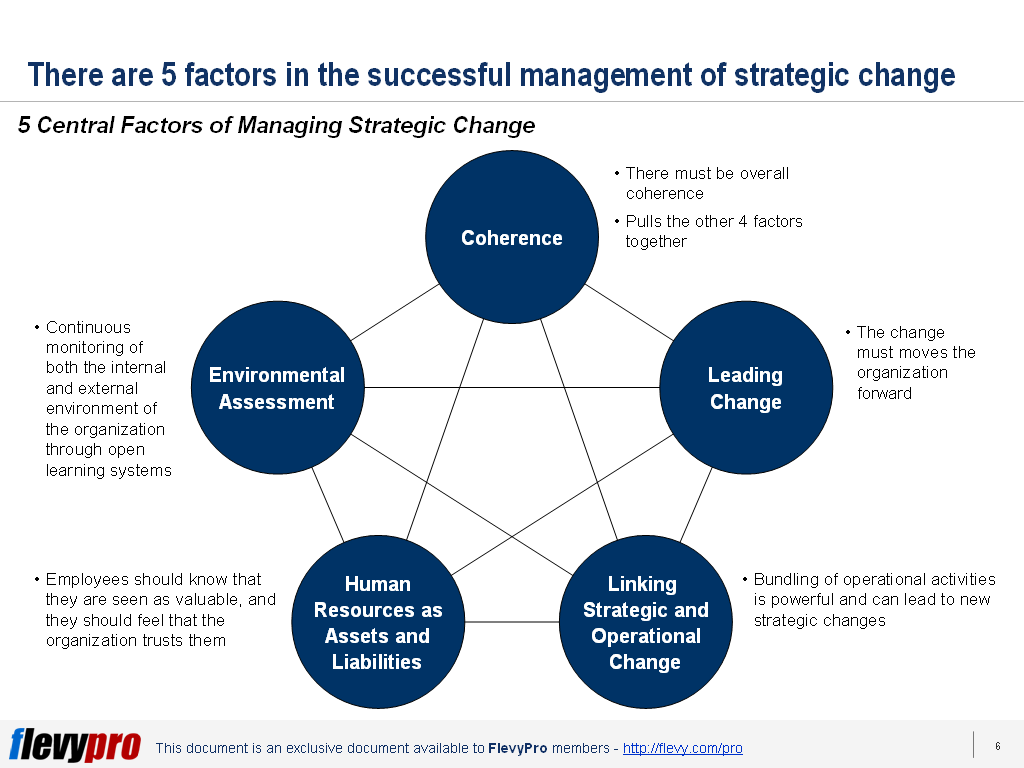Editor's Note: Take a look at our featured best practice, A Comprehensive Guide to Change Management (586-slide PowerPoint presentation). This "new and improved" A Comprehensive Guide to Change Management,, which replaces my previous "best seller" of the same name, contains everything (well nearly everything) you would ever want to know about Change Management. This slide-deck now contains over 580 slides which includes [read more]
Also, if you are interested in becoming an expert on Change Management, take a look at Flevy's Change Management Frameworks offering here. This is a curated collection of best practice frameworks based on the thought leadership of leading consulting firms, academics, and recognized subject matter experts. By learning and applying these concepts, you can you stay ahead of the curve. Full details here.
* * * *
Let’s first define Strategic Change.
A restructuring of an organization’s business or marketing plan that is typically performed in order to achieve an important objective. For example, a strategic change might include shifts in a corporation’s policies, target market, mission or organizational structure. — BusinessDictionary
 There’s no doubt that Strategic Change–or any change of such magnitude and impact on an organization–is difficult. To successfully execute such a change initiative, we need to understand the Dimensions of Strategic Change, as identified by Andrew Pettigrew and Richard Whipp. There are 3 such dimensions:
There’s no doubt that Strategic Change–or any change of such magnitude and impact on an organization–is difficult. To successfully execute such a change initiative, we need to understand the Dimensions of Strategic Change, as identified by Andrew Pettigrew and Richard Whipp. There are 3 such dimensions:
- Content of Change – Objectives, purpose, and goals of the strategy.
- Process of Change – Implementation of the strategy.
- Context of Change – The internal (e.g. management decisions) and external (e.g. competition) environment, in which the strategy operates.
Among these 3 change dimensions, there is continuous interaction. The 3 dimensions are also interdependent with each other. For instance, Context and Process define the Content of change.
This model proposes change should not be considered only in terms of the processes, but should also consider the historical, cultural, and political features of the organization. In fact, successful change is a result of the interaction between the content or “what” of change; the process or “how” of change; and the organizational context or “where” of change.
Let’s delve a bit deeper into these dimensions.
Content of Change
As mentioned, this focuses on objectives, purposes, and goals of the strategy. Change as Content looks at organizational parameters before and after an event in the life of the organization. Here, we try to understand what the possible antecedents and consequences of the change could have been.
Process of Change
Change as Process is concerned with understanding the actual change as it unfolds, including the role of the manager as a change agent. It refers to the way the change in content occurs–e.g. the speed, sequence of activities, decision-making and communication systems deployed, and the resistance encountered. The key question here is: How do we create the benefits?
Context of Change
The Context of Change is the situation surrounding the organization–the playing field from where the forces of change emanate and where the change is accomplished. “Outer context” refers to the political, economic, social, technological, regulatory and competitive environment where the firm operates. “Inner context,” on the other hand, refers to the internal environment of the firm–its corporate culture, structure, formal and informal processes, political context, and power centers.
This Dimensions of Strategic Change framework is useful for understanding complexities of organizational change–even for smaller and ordinary levels of change.
Also, as identified in this model, there are 5 Central Interrelated Factors that allow for successfully managing strategic change:
- Environment Assessment
- Human Resources as Assets and Liabilities
- Linking Strategic and Operational Change
- Leading Change
- Coherence

You can learn more about the 5 factors and download an editable PowerPoint about the the Dimensions of Strategic Change here on the Flevy documents marketplace.

20-slide PowerPoint presentation
This document contains 6 frame Change Management frameworks that deal with the "soft" side of managing effective organizational change:
1. Dimensions of Change
2. Emotional Cycle of Change
3. Ingredients of Change
4. Level of Commitment
5. Phases of Team Building
6. Trust
[read more]
Want to Achieve Excellence in Change Management?
Gain the knowledge and develop the expertise to become an expert in Change Management. Our frameworks are based on the thought leadership of leading consulting firms, academics, and recognized subject matter experts. Click here for full details.
"The only constant in life is change." – Heraclitus
Such is true for life, as it is for business. The entire ecosystem our organization operates in—our customers, competitors, suppliers, partners, the company itself, etc.—is constantly changing and evolving. Change can be driven by emerging technology, regulation, leadership change, crisis, changing consumer behavior, new business entrants, M&A activity, organizational restructuring, and so forth.
Thus, the understanding of, dealing with, and mastery of the Change Management process is one of the most critical capabilities for our organization to develop. Excellence in Change Management should be viewed as a source of Competitive Advantage.
Learn about our Change Management Best Practice Frameworks here.
Readers of This Article Are Interested in These Resources

50-slide PowerPoint presentation
Change Readiness Assessments are crucial tools used during the planning stage of a Change Management initiative. They help in gauging an organization's preparedness to embrace, implement, and sustain Change effectively.
These assessments can be utilized before major transitions or
[read more]

24-slide PowerPoint presentation
Seventy percent of change programs fail, according to the April 2001 Harvard Business Review article, "Cracking the Code of Change". According to Bain & Company, businesses that implement fast, focused, and simultaneous change programs can create enormous and long-lasting shareholder value.
[read more]

19-slide PowerPoint presentation
This is a collection of common Strategy and Management Consulting Frameworks. A Management Consulting Framework provides a structured approach to analyzing and solving a common business problem. It allows Management Consultants to address a client’s business issue in an organized, thorough, and
[read more]

73-slide PowerPoint presentation
Change is the only constant in the work environment today. However, a McKinsey study revealed that 70% of change programs fail, most often due to resistance from employees. For change to be successful, it has to be effectively managed. To achieve this, it is essential that the human side of change
[read more]
 There’s no doubt that Strategic Change–or any change of such magnitude and impact on an organization–is difficult. To successfully execute such a change initiative, we need to understand the
There’s no doubt that Strategic Change–or any change of such magnitude and impact on an organization–is difficult. To successfully execute such a change initiative, we need to understand the 




